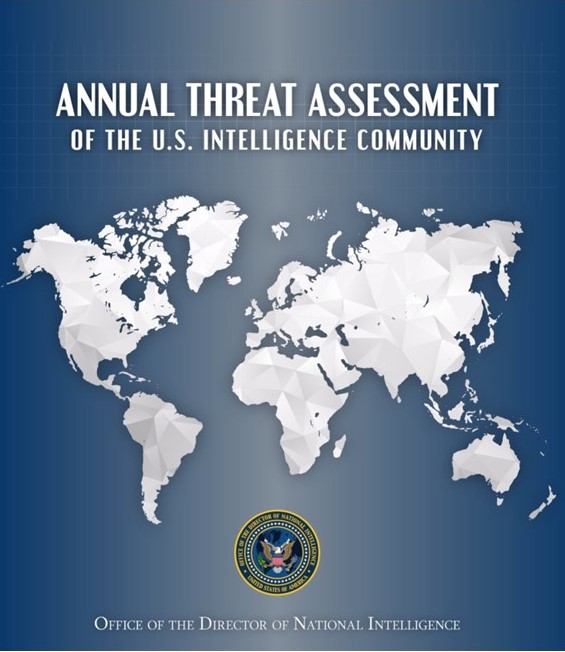Image: Director National Intelligence
What’s New: The Director of National Intelligence’s 2023 Threat Assessment reinforced existing info about the threats by Russia and China against our space-based assets.
Why its Important:
- China and Russia have alternatives to GPS and other space-based PNT sources. The US and NATO do not.
- Some analysts estimate that China will have enough anti-satellite weapons in space within the next two or three years to disable all GPS satellites at once, and have some left over for other targets.
- Many analysts believe that GPS will be the first thing to fall in a conflict with China.

2023 ANNUAL THREAT ASSESSMENT OF THE U.S. INTELLIGENCE COMMUNITY
[Excerpts for China]
China is steadily progressing toward its goal of becoming a world-class space leader, with the intent to match or surpass the United States by 2045. Even by 2030, China probably will achieve world-class status in all but a few space technology areas. China’s space activities are designed to advance its global standing and strengthen its attempts to erode U.S. influence across military, technological, economic, and diplomatic spheres.
- China’s space station began assembly and crewed missions in 2021, and reached full operational capability in 2022. Beijing plans to conduct additional lunar exploration missions, and it intends to establish a robotic research station on the Moon and later, an intermittently crewed lunar base.
- The PLA will continue to integrate space services—such as satellite reconnaissance and positioning, navigation, and timing—and satellite communications into its weapons and command-and-control systems in an effort to erode the U.S. military’s information advantage.
China’s commercial space sector is growing quickly and is on pace to become a major global competitor by 2030. Beijing’s policies to encourage private investment in space activities have influenced a broad range of firms to enter the commercial market. State-owned enterprises and their subsidiaries will remain the primary players in the Chinese commercial space sector, which also includes research and development spinoffs, established companies, and a growing number of startups.
- Some Chinese commercial space companies will attempt to compete by providing services in niche markets with little or no global competition, such as hyperspectral imaging, and also will continue attempts to undercut the price of Western firms in more competitive markets.
Counterspace operations will be integral to potential PLA military campaigns, and China has counterspaceweapons capabilities intended to target U.S. and allied satellites. The PLA is fielding new destructive and nondestructive ground- and space-based antisatellite (ASAT) weapons.
- China already has fielded ground-based counterspace capabilities including electronic warfare systems, directed energy weapons, and ASAT missiles intended to disrupt, damage, and destroy target satellites. China also has conducted orbital technology demonstrations, which while not counterspace weapons tests, prove China’s ability to operate future space-based counterspace weapons.
[Excerpts for Russia]
Russia will remain a key space competitor, but it may have difficulty achieving its long-term space goals because of the effects of additional international sanctions and export controls following its invasion of Ukraine, a myriad of domestic space-sector problems, and increasingly strained competition for program resources within Russia. Moscow probably will focus on prioritizing and integrating space services—such as communications; positioning, navigation, and timing; geolocation; and intelligence, surveillance, and reconnaissance— deemed critical to its national security.
- Moscow is capable of employing its civil and commercial remote sensing satellites to supplement military-dedicated capabilities that reduce the U.S. ability to perform sensitive military activities [ 16 ] undetected. In addition to improving its launch capability, it is working to support human spaceflight and future deep space missions.
- Russia warned during a UN meeting in October 2022 that commercial infrastructure in outer space used for military purposes “can become a legitimate target for retaliation.”
Russia continues to train its military space elements, and field new antisatellite weapons to disrupt and degrade U.S. and allied space capabilities. It is developing, testing, and fielding an array of nondestructive and destructive counterspace weapons—including jamming and cyberspace capabilities, directed energy weapons, on-orbit capabilities, and ground-based ASAT capabilities—to try to target U.S. and allied satellites. Similar to the space sector, resource and technology challenges could have an impact on the quality and quantity of Russia’s future counterspace capabilities.
- Russia is investing in electronic warfare and directed energy weapons to counter Western on-orbit assets. These systems work by disrupting or disabling adversary C4ISR capabilities and by disrupting GPS, tactical and satellite communications, and radars. Russia also continues to develop ground-based ASAT missiles capable of destroying space targets in low Earth orbit.


